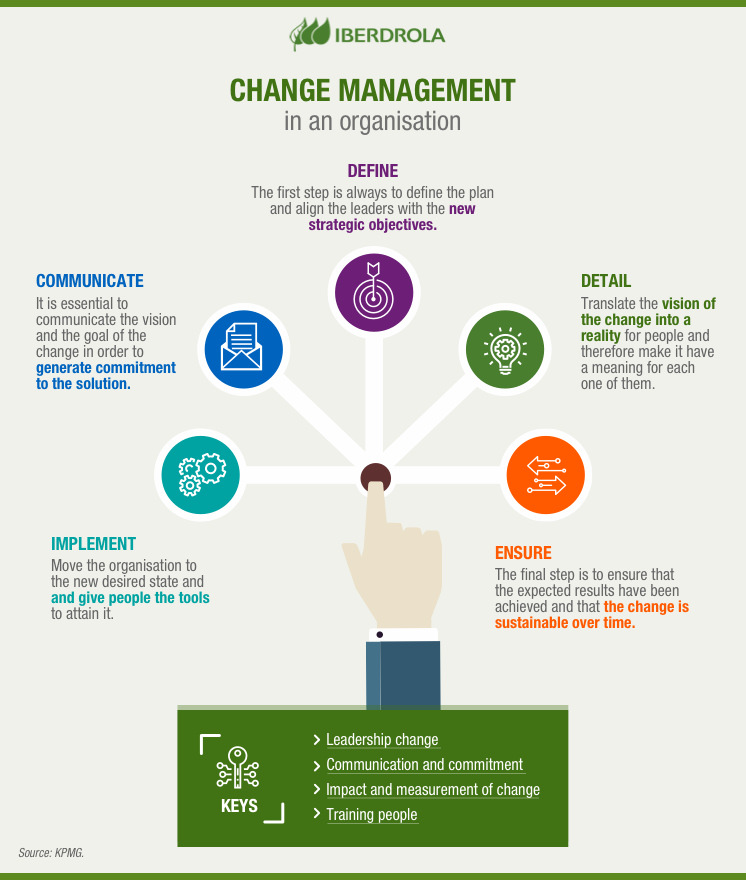Change management
Change management: a basic skill for companies and people in the 21st century
The world is changing at a dizzying rate and this affects us both personally and at work. In this context, adapting to and managing change has become a fundamental skill for dealing with the present and the future. In addition, it is a clear indicator of professional leadership because organisations require leaders who are also agents of change.

Change is a human constant, as Heraclitus said twenty centuries ago, but back then this Greek scholar could have never predicted the breakneck speed at which these changes would occur today. Technology evolves so fast that each advance becomes almost obsolete overnight and so the world of work is forced to adopt new technologies, new ways of working and new ways of interacting. How can it be done and guarantee success? The answer is change management.
What is change management?
The prestigious consulting firm KPMG provides the following definition: "Change management seeks to facilitate and achieve the successful implementation of transformation processes, which involves working with and for people in accepting and assimilating change and reducing resistance to it." Digital transformation has revolutionised company cultures and therefore this process answers the need to deal with fast-paced and important changes. The most frequent are: technological changes, changes in the business model, changes at the organisational and process levels, etc.
Why organisational and personal change managment is important
The consequences of changes always affect people, who are a company's main asset, and therefore it is essential to have their support. People are generally reluctant to change because of the insecurity and uncertainty they create. According to several human resources consultants, the capacity to know how to adapt to and manage change is a clear indicator of professional leadership because leaders must act as agents of change in the current context.
People who become aware of the need for organisational change grow more committed to the company and to the success of the process, demonstrate that they are capable of dealing with new challenges and develop greater self-confidence. To do this, at the organisational level it is necessary to foster trust in management, generate a constant flow of information and create an environment that makes other colleagues a good influence.
At the same time, it is essential to properly manage feelings of resistance to change so as to avoid negative consequences, both for employees — frustration, emotional instability and stress —, and for organisations — lower productivity, failure to meet objectives or a bad environment — and to consolidate rapid, effective and lasting change. Robert Half, a benchmark international consultancy when it comes to human resources questions, says that "Companies must be very aware of the importance of managing change so as to reduce the impact on their employees."

The proactiveness of organisations in dealing with change will determine whether or not a company is able to adopt a new process or system. Therefore, for companies, change management helps to speed up transformations and, as a result, to make this ability a hallmark for the future. It also reduces incidents that could affect a project's economic efficiency, boosts internal relations and communications and strengthens the human capital's sense of belonging.
Keys to adapting to change
The need to know how to adapt to changes was already well understood by the naturalist Charles Darwin with his famous theory of evolution. Adapted to today's world, the key is to establish a clear, structured framework for managing the effects of change. There are many theories, but one of the most accepted continues to be that formulated by John Kotter, professor of leadership at the Harvard Business School, in his book Leading Change (1995).
Kotter started from the premise that for a change to be successful directors, managers and senior executives have to want the change to happen. From there, the author established eight steps or phases that are listed below:
 Create a sense of urgency
Create a sense of urgency
Make change look like a necessity for each and every member of the company. For example, change can be proposed as a business opportunity.
 Build a coalition
Build a coalition
Identify different leaders within the company to establish an alliance. The aim is to bring together people who share the same vision in order to involve them in the change process.
 Create a road map
Create a road map
To reduce resistance within the organization, it is essential to establish a way forward. The path must be easy to communicate, understand and remember.
 Communicate effectively
Communicate effectively
The road map must be transmitted persistently. To do so, it is essential to respond honestly to all the doubts and fears raised by the members of the organisation.
 Remove barriers
Remove barriers
Once the majority of the members are convinced of the benefits of the change, it will be time to make it effective and to detect possible barriers at the organisational level as they arise.
 Ensure short term wins
Ensure short term wins
Change can be a long process and is not without difficulties. Therefore, the best way to maintain motivation is by setting short-term goals that allow progress to be observed.
 Build on change
Build on change
The roadmap is not monolithic, but can be revised during the process so that neither small wins are seen as the final success nor small failures lead to frustration.
 Anchor the change in the company
Anchor the change in the company
Once the change has been brought about, the time comes to consolidate it and make it a part of the company culture. In this way, the following changes will be seen as a development.





